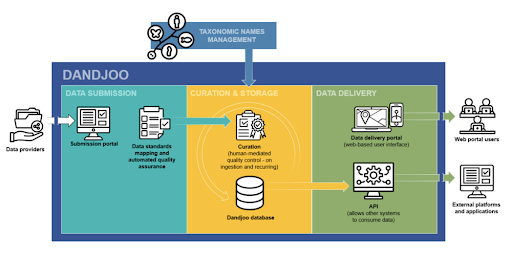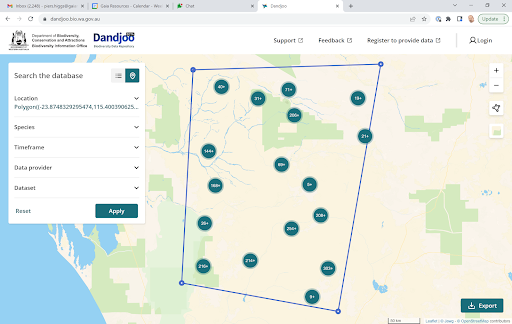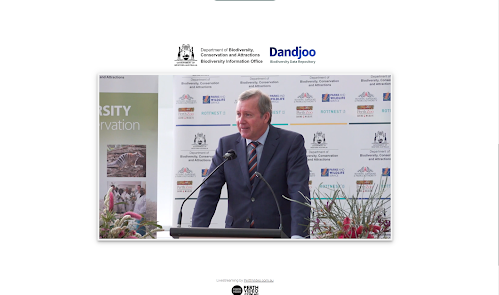Back in July, the Minister for Environment and Climate Action, the Honourable Reece Whitby MLA, along with the Department of Biodiversity, Conservation and Attractions (DBCA) Director General, Mark Webb, and their Executive Director, Margaret Byrne launched the new Dandjoo system (meaning “together” in the Noongar language) for the Biodiversity Information Office (BIO). You can re-watch the launch by clicking on the image below:
Leading up to this launch was nine months of very intense, challenging and time sensitive work by the team here at Gaia Resources, along with the DBCA BIO team, lead by Helen Ensikat. As we look towards the next stage of Dandjoo with the BIO team, it’s a good opportunity to look back at that nine months and to celebrate what has been achieved from that hard work!
The title of this blog covers one of the main things that has been achieved – as a collective, we’ve managed to implement a new generation of biodiversity information management. This new way is not looking at standards as the way to store data, but is offering the ability to store every piece of information that is provided, and then to use standards to make that available. I’ve written a separate blog back in June about how data standards should be used responsibly, all about this, so I won’t harp on from here, other than to say that the legacy that Paul Gioia left us is going on strong in the architecture of Dandjoo (summarised below, from the BIO team).

Dandjoo is made up of multiple components, including data submission, curation, storage, data delivery and taxonomic names management (Credit: DBCA)
The parts of Dandjoo that are visible to the public are at either end – the data submission and data delivery pieces. These are where the whole team spent a lot of time trying to get this right, and to a large degree, that’s been done. A big part of this success has been to the data interface design work we ran with our partners, Liquid Interactive.
As a result of this work, the data delivery portal (https://dandjoo.bio.wa.gov.au/) is a modern, streamlined application that is primed to move to the next stages of development, adding in new functionality that’s been requested after the initial launch. We hope to be working with the BIO team into the future on aspects of this, but a key aspect is that this system is owned and operated by the BIO team.

The Dandjoo interface went through a range of user interface design work to deliver the modern, streamlined application that was launched in July
That’s a very important part of the BIO project to date – making sure that the BIO team can own this system and build upon the initial short nine month development piece to enhance and drive this with their own team. This is a key part of our approach at Gaia Resources – making sure solutions are sustainable also means making sure that the clients can (if they wish to) work on the system themselves into the future.
The data submission piece is where the next generation thinking really comes to play, and where Dandjoo implements data standards in a new way.
Instead of forcing people to discard data that does not fit, what instead happens is that data providers are asked to “map” the fields in their dataset to the data standards that are utilised under the hood (starting with Darwin Core, as outlined in https://bio.wa.gov.au/dandjoo/guide/data-standards-dandjoo). By going down this route, Dandjoo has all the valuable data that has been collected – not just those that are in the standard. This helps to future proof the data repository – if data standards change, the BIO team can re-map fields from the original datasets to add in new data, without going back for resupplies of the datasets.
This is such a key part of the design of Dandjoo, that to me it’s the most important thing that we’ve implemented – it does add some overheads for processing and the like, but the data collected on biodiversity surveys is precious and should all be retained – you might hear my inner archivist firing up here, and indeed it’s a lot of archival and record management thinking from our work in that area that has informed this design as well.
It’s something I’m really proud of our team for implementing – even more so than the other public parts of Dandjoo – because this to me is all about our core mission statement, to make the world a better place. With the collective wisdom from the BIO team, people who were involved in the previous design phases, and the team over at the Biodiversity Data Repository in the Department of Climate Change, Energy, Environment and Water (more on our work with them in another blog to come), we have really developed something special, and it will continue to get even better.
Dandjoo has been a big project for Gaia Resources over the last year or so, and I can’t stress how grateful I am to have had such a great team of people working together on this, both from our side, led by Tanya Aquino, and on the BIO side led by Helen Ensikat, to implement this system. It’s been a really intense project but collectively we have delivered a system that is the start of a new chapter in how biodiversity data is managed in Western Australia.
I can’t wait to see what the next year brings for the BIO team and what they will do with Dandjoo – and the delivery of Dandjoo in only nine months, under a great deal of pressure all around, is one the team involved and I will look back on in the future with a great deal of pride on.
If you’d like to know more, start a conversation on our social media platforms – Twitter, LinkedIn or Facebook or send us an email
Piers


Comments are closed.